New luxury stay immerses you in this national park’s sublime scenery
It’s the rising of the dird and we are gathered at a table under the stars. The tables are lit by candles, twinkling lights, starlight and moonlight – for that is what the dird is. It is the moon, in Kundjeyhmi, the most widely spoken, remaining language of the peoples of Kakadu.
We are seated for a Dird Full Moon Feast at Cooinda Lodge in the centre of Kakadu National Park and for the next few hours, the yields of a rich, beautiful land are laid on the tables before us. An-kulurrudj, namarnkol, anaburru. (Bush cabbage, barramundi, buffalo.) They are all on the four-course Bininj (Indigenous) menu tonight, many of the ingredients painstakingly foraged by hand from the billabongs, grasslands and the stone country around us.
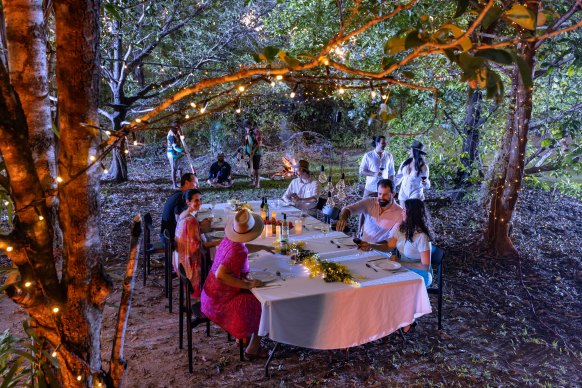
Kakadu Dird or Full Moon Feast.
All the senses are immersed throughout dinner, from the low rumble of the didgeridoo which resonates through my blood, the sweetness of the Davidson Plum spritz, the scent of the Kakadu plum and bush cucumber candles, all overlaid with the very Territory tang of insect repellent.
There are six seasons in the Bininj-Mungguy calendar here. “We are entering Wurrkeng, cold weather season, now,” says our host and creator of Dird, local Bininj man Ben Tyler. “This is when we hunt kowarrang (echidna).”
Ben’s soft voice and gentle nature belie a deep, successful entrepreneurial spirit: a chef and founder of Kakadu Kitchen, he has teamed with Cooinda Lodge’s executive chef, Philip Foote, to create these moonlit feasts of seasonal, Indigenous foods, which are held in the lodge grounds. He’s hands-on, from cooking to MC-ing, and even forages for ingredients.
“We’ve got a few different eyes looking out for us on country. And sometimes it’s just me and mum (Traditional Owner Jessie Alderson) and we jump in the car and drive up to the rock country or on the floodplains, the billabongs,” says Ben. “We might drive a few hundred kilometres in a day to forage for bush foods. But foraging for us isn’t just going getting the ingredients; we’re burning country, looking after rock art, visiting sites, sharing intergenerational knowledge. We’re looking at tracks, seeing what animals are doing – we’re giving back to country as well as taking.”
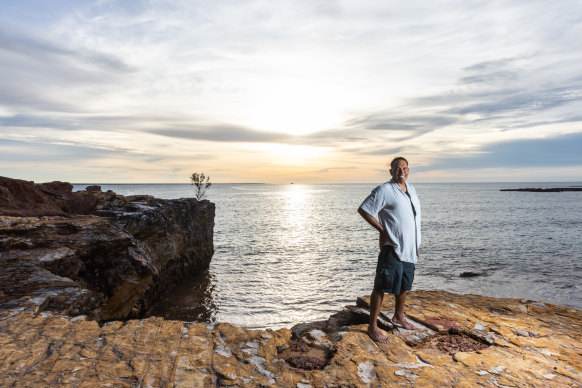
Kakadu Kitchen chef Ben Tyler.Credit: Helen Orr
Service is provided by a mix of foreign backpackers working at Cooinda Lodge and young, Indigenous locals, newly trained in hospitality and clearly delighted at their first gig.
“Kamak! Enjoy!” encourages Ben, as the servers fill the table with damper, salt-bush butter and delicious alcohol-free drinks. The buffalo has been slow-cooked kunkedi-style, in a ground oven, its soft, smoky flavour offset by black garlic and pickled lily stems and flowers. But the stand-out is the barramundi, smoked in paperbark leaves and served in a leek and potato puree. The night ends with heartfelt thanks from Ben, chef Phillip and some of the staff, who are, like us, so thrilled to be part of what is shaping up as a success story of Indigenous tourism.
Our home tonight is one of Cooinda’s new Yellow Waters villas, a short after-dinner stroll away. Each of the five villas is named for an Indigenous animal from the region, and ours is gabor (green ant). Kundjeyhmi language is everywhere, as it should be.
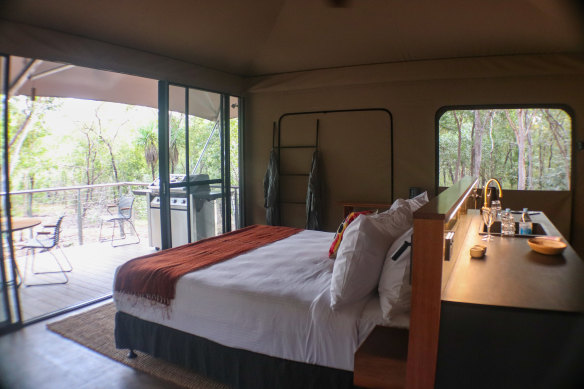
Yellow Water villas, Cooinda.
It’s already quiet at 10pm. Holidaying in Kakadu is an early-morning scene and most guests have already bedded down in humble tents, kitted-out caravans, pimped motorhomes or motel rooms.
Set apart from the vans, the pool, the restaurants and the reception, the villas’ closest neighbours – physically and evolutionarily – are the 20 air-conditioned Outback Retreats, which are neat canvas tents set on low platforms with a shared amenities block.
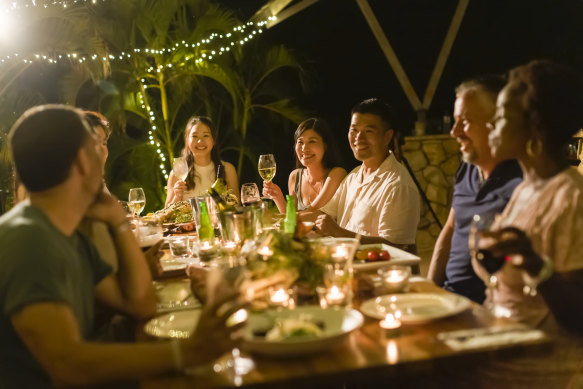
Cooinda Lodge, Kakadu.
In comparison, our villas are fully self-contained, with a kitchen, bathroom and a barbecue on the deck. Raised on high platforms, gabor looks into the scrub and the small, undoubtedly croc-riddled, Home Billabong beyond.
It’s the (alleged) cool season but as a southerner, I giggle in disbelief as it’s in the mid-20s. We forgo the aircon and pull only the screen doors closed to listen to the bush, which creaks and snaps with the calls and footfalls of night creatures.
Then, our party of two – me and my Darwin-born sister-in-law – pull out the robes, slippers and the welcome bottle of wine waiting in the fridge. We’re too full for the complementary dessert platter, instead saving it for our planned barbie on the deck tomorrow night.
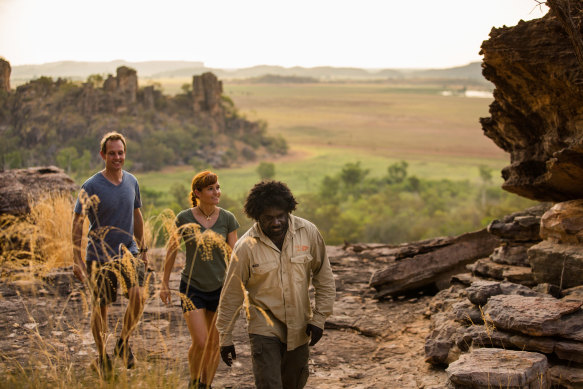
Guided Indigenous walk.
A stack of books sits on the small desk with some big names, including Marcia Langton and Bruce Pascoe. There’s also Ben Tyler’s children’s book, Walking in Gagadju Country and a bright orange self-published book by Judy Opitz, Kakadu’s so-called “English rose”, who is said to have been the blueprint for Nicole Kidman’s character in Baz Luhrmann’s outback epic, Australia. In the 1960s, the 10-Pound Pom married a local croc-hunter and set up a small store at nearby Jim Jim billabong that paved the way for tourism in Kakadu.
It’s the sort of read you’d rip through in a long soak, and there is a deep bathtub out on the open deck. The only problem is that these villas are so new, the screening hedges have not yet been planted, so modesty trumps luxury and instead, I read of Judy and husband Tom’s wild adventures from the comfort of the king-sized bed. It’s no second best: there are Bose speakers for our music, and the many throws and cushions are from Better World Arts in Adelaide, which I love for its decades-long support of the arts in Australia’s remote Indigenous communities.
The next morning, we flip the sign on our door to “gone walkabout” and head to the buffet breakfast at the main restaurant. To shake down the bacon and eggs, we take a gentle bushwalk through the art galleries at Burrungkuy/Nourlangie Rock, while away an hour at the Warradjan Cultural Centre, and then shop the Indigenous-owned and created handcrafts, art, earrings and organic oils and candles I spied at our Dird dinner. They’re made by Kakadu Organics, which also supplies our villa’s soaps and lotions, scented with tea tree and lemon balm.
We then join Mandy Muir, descendant of the Murumburr people, on a boat for one of the Territory’s signature experiences, a cruise down Ngurrungurrudjba (Yellow Water) billabong. Mandy is Ben’s older sister and the longest-serving guide here in Kakadu, and runs a funny, very dry exploration of Kakadu’s most popular adventure.
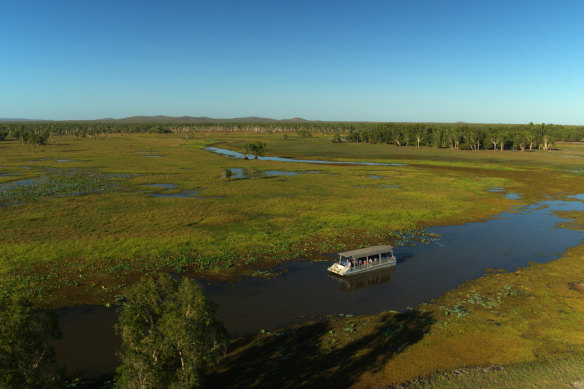
Yellow Water Billabong.
Like most billabongs here, it’s choc-full of crocs who steal the show as they line up on the riverbanks, and everyone snaps the snappers. But we also spy herds of buffalo and wild horses, black-headed storks, ibis, egrets, kingfishers and thousands of ducklings who wander – ignorant in their youth – past the open jaws of cooling crocs.
On our second and final night in the villa, we’ve planned a barbecue on the deck, but our fallback plan is Cooinda’s tasting plate from the restaurant. Stacked with salt & pepper crocodile, buffalo fillet, paperbark-wrapped barra and condiments spiced with quandong, bush tomato or lemon myrtle, it’s perfect if your visit doesn’t coincide with the Dird feasts.
Otherwise, Ben suggests going out on country with one of the local tours, such as Animal Tracks Safari or Mandy’s Kakadu Billabong Safari Camp, to wild harvest and cook on the land.
With less than half the visitors of Uluru, Kakadu is a different beast – less accommodation, less structure and less tourism industry. But I feel grounded in this landscape; it surrounds me and draws me in, rather than remaining aloof and waiting to be admired.
And just three hours’ drive from Darwin, Kakadu is only a mini-roadtrip on sealed roads. Yet our days have been filled with sacred art, rare foods and stories. And the sublime scenery of another more beautiful, peaceful world.
The writer travelled courtesy of NT Tourism. See northernterritory.com
THE DETAILS
DRIVE
Cooinda Lodge is three hours’ drive from Darwin via Jabiru.
EAT + STAY
Yellow Water Villas from $950 a night (sleeps two adults + two children), B&B. Dird Full Moon Dinners are held six times a year at Cooinda Lodge, April-October, $189 a person. See kakadutourism.com
TOUR
Yellow Waters Billabong cruises run from dawn until dusk, from $109.
Sign up for the Traveller Deals newsletter
Get exclusive travel deals delivered straight to your inbox. Sign up now.